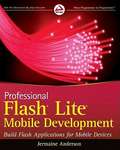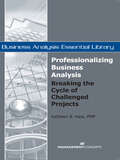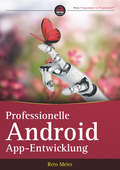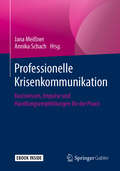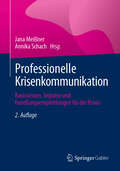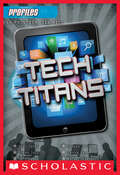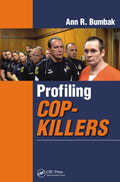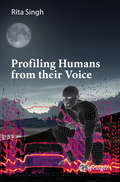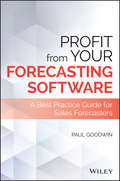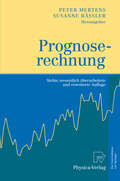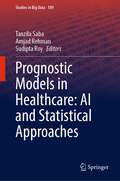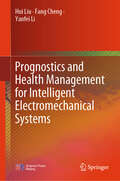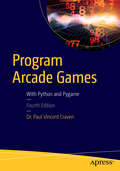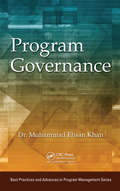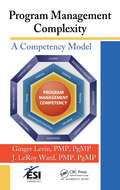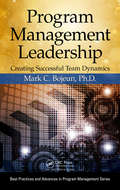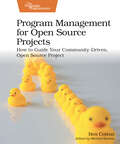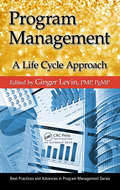- Table View
- List View
ProfessionalFlash® Lite® Mobile Development
by Jermaine G. AndersonEverything you need to start developing for mobile devices today Adobe Flash Lite allows you to quickly create and publish engaging mobile content for games, wallpapers, video, music, or applications. With this essential guide, you'll discover how to develop applications for Flash-enabled mobile devices using ActionScript 2. 0 and the latest version of Flash Lite. Detailed walkthroughs take you from concept to completion for a variety of examples. The author provides an overview on extending Flash Lite capabilities and shows you how to distribute complete applications using the Adobe Distributable Player and Packager. Discover how Adobe Flash Lite allows you to quickly create engaging mobile content to Flash-enabled mobile devices Demonstrates every step in the development process, from concept to completion Reinforces four critical topics throughout the book: ActionScript 2. 0 mobile device considerations, PureMVC framework, native device properties, and the ability to extend Flash Lite This in-depth exploration of Adobe Flash Lite is no lightweight! Note: CD-ROM/DVD and other supplementary materials are not included as part of eBook file.
Professionalizing Business Analysis: Breaking the Cycle of Challenged Projects
by Kathleen B. Hass PMPA Volume of the Business Analysis Essential Library Series Uncover the role of the business analyst as the business and technology strategist who provides the executive leadership team with the information, process, tools, and capability to make the best decisions. The Business Analyst as Strategist: Translating Business Strategies into Valuable Solutions outlines the first two phases of the business solution life — strategic planning and enterprise analysis –– that the future vision of the enterprise is established, strategic goals and measures are set, and the most viable programs and supporting projects are initiated to achieve the strategy. Learn how to set the stage for change, and how to translate your strategy into operational terms through a portfolio of programs and supporting projects. Understand the five-step process to set well-formed strategies and how to execute them. Through this book you will master business analysis competencies, learn how to react effectively, anticipate changes in the marketplace, and flow value through the enterprise to the customer, thus achieving competitive advantage.
Professionalizing the Nation's Cybersecurity Workforce?
by National Research Council Computer Science and Telecommunications Board Division on Engineering and Physical Sciences Committee on Professionalizing the Nation's Cybersecurity Workforce: Criteria for Future Decision-MakingProfessionalizing the Nation's Cybersecurity Workforce? Criteria for Decision-Making considers approaches to increasing the professionalization of the nation's cybersecurity workforce. This report examines workforce requirements for cybersecurity and the segments and job functions in which professionalization is most needed; the role of assessment tools, certification, licensing, and other means for assessing and enhancing professionalization; and emerging approaches, such as performance-based measures. It also examines requirements for the federal (military and civilian) workforce, the private sector, and state and local government. The report focuses on three essential elements: (1) understanding the context for cybersecurity workforce development, (2) considering the relative advantages, disadvantages, and approaches to professionalizing the nation's cybersecurity workforce, and (3) setting forth criteria that can be used to identify which, if any, specialty areas may require professionalization and set forth criteria for evaluating different approaches and tools for professionalization. Professionalizing the Nation's Cybersecurity Workforce? Criteria for Decision-Making characterizes the current landscape for cybersecurity workforce development and sets forth criteria that the federal agencies participating in the National Initiative for Cybersecurity Education--as well as organizations that employ cybersecurity workers--could use to identify which specialty areas may require professionalization and to evaluate different approaches and tools for professionalization.
Professionelle Android App-Entwicklung
by Reto MeierReto Meier, Entwickler und Führungskraft bei Google, verrät Ihnen in diesem Buch seine vielversprechendsten Techniken und Erfolgsrezepte. Sie erfahren, wie Sie die neuesten Features von Android am besten einsetzen und wie Sie damit schnell und sicher robuste und überzeugende Apps entwickeln. Anhand zahlreicher Beispielprojekte erhalten Sie einen tiefen Einblick in die aktuelle Android-Plattform. Die Übungen beginnen einfach, mit allmählich wachsendem Schwierigkeitsgrad.
Professionelle Krisenkommunikation: Basiswissen, Impulse und Handlungsempfehlungen für die Praxis
by Annika Schach Jana MeißnerNutzen Sie dieses Buch als Grundlage für Ihre KrisenkommunikationSie möchten die Krisenkommunikation in Ihrem Unternehmen verbessert? Dieses Werk gibt Praktikern zahlreiche Tipps, wie sie mit problematischen Situationen umgehen können.Lernen Sie, wie Sie Unternehmenskrisen bewältigen. Doch nicht nur das, auch das Risikomanagement und die Krisenprävention spielt eine wichtige Rolle. Darüber hinaus vermittelt dieses Buch verschiedene wissenschaftliche Erkenntnisse aus dem Bereich der Krisenkommunikation.Die Herausgeber richten sich unter anderem an:• Unternehmer und Führungskräfte• Risiko- und Krisenmanager• KommunikatorenUm praktisches Fachwissen zu vermitteln, vereinen die Herausgeber die Beiträge verschiedener Experten aus Wissenschaft und Praxis. Unter anderem geht es dabei und das Business Continuity Management, interne Kontrollsystem und organisationale Resilienz. Darüber hinaus findet der Leser zahlreiche Handlungsempfehlungen für Krisenkommunikatoren.
Professionelle Krisenkommunikation: Basiswissen, Impulse und Handlungsempfehlungen für die Praxis
by Annika Schach Jana MeißnerDieses Buch beschreibt, wie Unternehmen Krisen kommunikativ erfolgreich managen und bewältigen können. Krisenkommunikation muss im Ernstfall schnell und hochprofessionell erfolgen. Dies gelingt nur, wenn Unternehmensführung, Krisen- und Risikomanagement, Fachabteilungen und die Unternehmenskommunikation vor, während und nach einer Krise zielorientiert zusammenarbeiten. Funktioniert das, können das (Krisen)Management und die (Krisen)Kommunikation das Vertrauen in eine Organisation sogar stärken. Expertinnen und Experten aus Praxis, Wissenschaft und Lehre vermitteln in diesem Buch, was erfolgreiche Krisenkommunikation auszeichnet und geben anhand von Beispielen konkrete Handlungsempfehlungen. Zu den behandelten Themen gehören neben dem Fokus auf die Krisenkommunikation unter anderen: Notfall- und Krisenmanagement, Risikomanagement, Business Continuity Management und weitere Managementsysteme Organisationaler Resilienz. Aktueller denn je ermöglicht dasBuch einen ganzheitlichen Blick auf die Krisenkommunikation und hilft Praktikern, ihre Kompetenzen zu erweitern und zu vertiefen.Die zweite Auflage wurde überarbeitet und um Beiträge zu den Themen Cyberangriffe, ChatGPT, Medienmonitoring und KI sowie zu Krisenkommunikation in Demokratien und im Insolvenzfall ergänzt.
Profiles #3: Tech Titans (Profiles #3)
by Carla Killough McclaffertyFull-color series-six bios in one! It takes more than one person to bring about change and innovation. Explore the lives of the people who have had a huge impact on technology today. So much more than just your typical biography, PROFILES: TECH TITANS focuses on six of the most prominent figures in the technological world. This book includes all of the biographical information kids need to know (background, family, education, accomplishments, etc.) about Bill Gates, Steve Jobs, Mark Zuckerberg, Larry Page, Sergey Brin, and Jeff Bezos--the men behind Windows, Apple, Facebook, Google, and Amazon! Photographs and quotes will be interwoven throughout the text.
Profiling Cop-Killers
by Ann R. BumbakDrawing heavily on original research designed to train police officers to survive deadly encounters, Profiling Cop-Killers examines the sociological history, psychology, and motives of 50 murderers of police officers in 2011. The book identifies the commonalities and differences between groups of offenders by age, examining the previously hidden co
Profiling Humans from their Voice
by Rita SinghThis book is about recent research in the area of profiling humans from their voice, which seeks to deduce and describe the speaker's entire persona and their surroundings from voice alone. It covers several key aspects of this technology, describing how the human voice is unique in its ability to both capture and influence the human persona -- how, in some ways, voice is more potent and valuable then DNA and fingerprints as a metric, since it not only carries information about the speaker, but also about their current state and their surroundings at the time of speaking. It provides a comprehensive review of advances made in multiple scientific fields that now contribute to its foundations. It describes how artificial intelligence enables mechanisms of discovery that were not possible before in this context, driving the field forward in unprecedented ways. It also touches upon related and relevant challenges posed by voice disguise and other mechanisms of voice manipulation. The book acts as a good resource for academic researchers, and for professional agencies in many areas such as law enforcement, healthcare, social services, entertainment etc.
Profinite Semigroups and Symbolic Dynamics (Lecture Notes in Mathematics #2274)
by Dominique Perrin Jorge Almeida Alfredo Costa Revekka KyriakoglouThis book describes the relation between profinite semigroups and symbolic dynamics. Profinite semigroups are topological semigroups which are compact and residually finite. In particular, free profinite semigroups can be seen as the completion of free semigroups with respect to the profinite metric. In this metric, two words are close if one needs a morphism on a large finite monoid to distinguish them. The main focus is on a natural correspondence between minimal shift spaces (closed shift-invariant sets of two-sided infinite words) and maximal J-classes (certain subsets of free profinite semigroups). This correspondence sheds light on many aspects of both profinite semigroups and symbolic dynamics. For example, the return words to a given word in a shift space can be related to the generators of the group of the corresponding J-class. The book is aimed at researchers and graduate students in mathematics or theoretical computer science.
Profit From Your Forecasting Software: A Best Practice Guide for Sales Forecasters (Wiley and SAS Business Series)
by Paul GoodwinGo beyond technique to master the difficult judgement calls of forecasting A variety of software can be used effectively to achieve accurate forecasting, but no software can replace the essential human component. You may be new to forecasting, or you may have mastered the statistical theory behind the software’s predictions, and even more advanced “power user” techniques for the software itself—but your forecasts will never reach peak accuracy unless you master the complex judgement calls that the software cannot make. Profit From Your Forecasting Software addresses the issues that arise regularly, and shows you how to make the correct decisions to get the most out of your software. Taking a non-mathematical approach to the various forecasting models, the discussion covers common everyday decisions such as model choice, forecast adjustment, product hierarchies, safety stock levels, model fit, testing, and much more. Clear explanations help you better understand seasonal indices, smoothing coefficients, mean absolute percentage error, and r-squared, and an exploration of psychological biases provides insight into the decision to override the software’s forecast. With a focus on choice, interpretation, and judgement, this book goes beyond the technical manuals to help you truly grasp the more intangible skills that lead to better accuracy. Explore the advantages and disadvantages of alternative forecasting methods in different situations Master the interpretation and evaluation of your software’s output Learn the subconscious biases that could affect your judgement toward intervention Find expert guidance on testing, planning, and configuration to help you get the most out of your software Relevant to sales forecasters, demand planners, and analysts across industries, Profit From Your Forecasting Software is the much sought-after “missing piece” in forecasting reference.
Profit and Prejudice: The Luddites of the Fourth Industrial Revolution
by Paul DonovanAvoiding prejudice will be critical to economic success in the fourth industrial revolution. It is not the new and innovative technology that will matter in the next decade, but what we do with it. Using technology properly, with diverse decision making, is the difference between success and failure in a changing world. This will require putting the right person in the right job at the right time. Prejudice stops that happening. Profit and Prejudice takes us through the relationship between economic success and prejudice in labour markets. It starts with the major changes that occur in periods of economic upheaval. These changes tend to be unpopular and complex – and complexity encourages people to turn to the simplistic arguments of ‘scapegoat economics’ and prejudice. Some of the changes of the fourth industrial revolution will help fight prejudice, but some will make it far worse. The more prejudice there is, the harder it will be for companies and countries to profit from the changes ahead. Profit is not the main argument against prejudice, but can certainly help fight it. This book tells a story of the damage that prejudice can do. Using economics without jargon, students, investors and the public will be able to follow the narrative and see how prejudice can be opposed. Prejudice is bad for business and the economy. Profit and Prejudice explains why.
Profit from Your Podcast: Proven Strategies to Turn Listeners into a Livelihood
by Dave JacksonMethods and Advice for Making the Most of Your Podcast—Pricing, Sponsors, Crowdfunding, and More Pick up any book on podcast monetization, and you will find 90 percent of it only covers how to launch a podcast. If you already have a podcast, you have that information; you&’re ready for the next step. Profit from Your Podcast provides top strategies and real-life examples of podcast monetization. This book is more than what to do. It also tells you how to do it. Chapters cover such topics as: How to Grow Your AudienceHow to Set Your PricingUnderstanding Advertising JargonHow to Find SponsorsBest Strategies for Making Money as an AffiliateMaster Strategies for CrowdfundingHarnessing the Power of Webinars and EventsThe Top Tools to Make Your Job Easy Built on the author&’s fifteen years of experience in podcasting, this action-packed guide will benefit new and veteran podcasters. Get clear on who your audience is and what they want, deliver value, and build an engaged audience that wants to give you money. Leverage your relationships and the integrity you have built through your podcast to create multiple streams of income. Profit from Your Podcast gives you the tools to do it all.
Profit over Privacy: How Surveillance Advertising Conquered the Internet
by Matthew CrainA deep dive into the political roots of advertising on the internet The contemporary internet&’s de facto business model is one of surveillance. Browser cookies follow us around the web, Amazon targets us with eerily prescient ads, Facebook and Google read our messages and analyze our patterns, and apps record our every move. In Profit over Privacy, Matthew Crain gives internet surveillance a much-needed origin story by chronicling the development of its most important historical catalyst: web advertising.The first institutional and political history of internet advertising, Profit over Privacy uses the 1990s as its backdrop to show how the massive data-collection infrastructure that undergirds the internet today is the result of twenty-five years of technical and political economic engineering. Crain considers the social causes and consequences of the internet&’s rapid embrace of consumer monitoring, detailing how advertisers and marketers adapted to the existential threat of the internet and marshaled venture capital to develop the now-ubiquitous business model called &“surveillance advertising.&” He draws on a range of primary resources from government, industry, and the press and highlights the political roots of internet advertising to underscore the necessity of political solutions to reign in unaccountable commercial surveillance.The dominant business model on the internet, surveillance advertising is the result of political choices—not the inevitable march of technology. Unlike many other countries, the United States has no internet privacy law. A fascinating prehistory of internet advertising giants like Google and Facebook, Profit over Privacy argues that the internet did not have to turn out this way and that it can be remade into something better.
Profitable Photography in the Digital Age: Strategies for Success
by Dan HellerThis groundbreaking resource demonstrates how to use digital imaging and the Internet as the cornerstone of a successful photography business. Topics covered include setting business goals, marketing, setting prices, selling prints, running a Web-based photography business, working with stock agencies, legally protecting images, and more. Both serious amateurs considering a start-up and established businesses looking for fresh approaches need this timely, relevant book.
Profitable Podcasting: Grow Your Business, Expand Your Platform, and Build a Nation of True Fans
by Stephen WoessnerDid you know there's a much better tool for spreading influence and generating revenue--one with far less competition? Podcasting offers rich opportunities, especially if you get in early and do it right.Author and CEO Stephen Woessner wants to share with you the secrets he learned in podcasting while building a $2 million venture from scratch. Profitable Podcasting lays out the precise formula Woessner has learned from experience to be necessary for creating, launching, marketing, and monetizing podcasts in any industry.Packed with priceless production help, software recommendations, web and social strategies, schedules, checklists, and examples, this indispensable guide explains exactly how to:Choose the ideal format for the type of show you are producingGet the best guestsCreate intriguing interview questionsRecord and edit like a proMaximize buzz for the launchSecure generous sponsorshipAchieve top rankings fastDon&’t let the tech side of this incredible marketing and sales outlet scare you away from the lucrative awards that await you once you conquer the short learning curve. With Profitable Podcasting navigating you through every step, you will reach the payoff quickly and painlessly.
Prognoserechnung
by Peter Mertens Susanne RässlerMit diesem Buch liegen kompakte Beschreibungen von Prognoseverfahren vor, die vor allem in Systemen der betrieblichen Informationsverarbeitung eingesetzt werden. Praktiker mit langjähriger Prognoseerfahrung zeigen außerdem, wie die einzelnen Methoden in der Unternehmung Verwendung finden und wo die Probleme beim Einsatz liegen. Das Buch wendet sich gleichermaßen an Wissenschaft und Praxis. Das Spektrum reicht von einfachen Verfahren der Vorhersage über neuere Ansätze der künstlichen Intelligenz und Zeitreihenanalyse bis hin zur Prognose von Softwarezuverlässigkeit und zur kooperativen Vorhersage in Liefernetzen. In der siebenten, wesentlich überarbeiteten und erweiterten Auflage werden neue Vergleiche von Prognosemethoden, GARCH-Modelle zur Finanzmarktprognose, "Predictive Analytics" als Variante der "Business Intelligence" und die Kombination von Vorhersagen mit Elementen der Chaostheorie berücksichtigt.
Prognostic Models in Healthcare: AI and Statistical Approaches (Studies in Big Data #109)
by Sudipta Roy Tanzila Saba Amjad RehmanThis book focuses on contemporary technologies and research in computational intelligence that has reached the practical level and is now accessible in preclinical and clinical settings. This book's principal objective is to thoroughly understand significant technological breakthroughs and research results in predictive modeling in healthcare imaging and data analysis. Machine learning and deep learning could be used to fully automate the diagnosis and prognosis of patients in medical fields. The healthcare industry's emphasis has evolved from a clinical-centric to a patient-centric model. However, it is still facing several technical, computational, and ethical challenges. Big data analytics in health care is becoming a revolution in technical as well as societal well-being viewpoints. Moreover, in this age of big data, there is increased access to massive amounts of regularly gathered data from the healthcare industry that has necessitated the development of predictive models and automated solutions for the early identification of critical and chronic illnesses. The book contains high-quality, original work that will assist readers in realizing novel applications and contexts for deep learning architectures and algorithms, making it an indispensable reference guide for academic researchers, professionals, industrial software engineers, and innovative model developers in healthcare industry.
Prognostics and Health Management for Intelligent Electromechanical Systems
by Hui Liu Yanfei Li Fang ChengThis book gives a detailed introduction to the technical background, feature extraction methods, PHM models and big data embedding methods of the big data theory in PHM for intelligent electromechanical systems. Combination with deep learning and big data, this book explains the hybrid algorithm framework of PHM such as ensemble intelligence and optimized intelligence and introduces PHM models for bearing, IGBT, MOSFET and other components and their big data embedding platform. This book improves the PHM method and theory of electromechanical system under industrial big data and provides reference for the development of intelligent electromechanical equipment and intelligent industrial production in the future.
Program Arcade Games
by Paul Vincent CravenLearn and use Python and PyGame to design and build cool arcade games. In Program Arcade Games: With Python and PyGame, Fourth Edition, Dr. Paul Vincent Craven teaches you how to create fun and simple quiz games; integrate and start using graphics; animate graphics; integrate and use game controllers; add sound and bit-mapped graphics; and build grid-based games. After reading and using this book, you'll be able to learn to program and build simple arcade game applications using one of today's most popular programming languages, Python. You can even deploy onto Steam and other Linux-based game systems as well as Android, one of today's most popular mobile and tablet platforms. What you'll learn How to create quiz games How to integrate and start using graphics How to animate graphics How to integrate and use game controllers How to add sound and bit-mapped graphics How to build grid-based games Who this book is for This book assumes no prior programming knowledge. Table of Contents 0. Before Getting Started 1. Create a Custom Calculator 2. What is a Computer Language? 3. Quiz Games and If Statements 4. Guessing Games with Random Numbers and Loops 5. Introduction to Graphics 6. Back to Looping 7. Introduction to Lists 8. Introduction to Animation 9. Functions 10. Controllers and Graphics 11. Bitmapped Graphics and Sound 12. Introduction to Classes 13. Introduction to Sprites 14. Libraries and Modules 15. Searching 16. Array-Backed Grids 17. Sorting 18. Exceptions 19. Recursion 20. Formatting 21. Labs 22. Appendix A. Example code and programs 23. Appendix B: Sample Tests 24. Appendix C: Worksheets 25. Appendix D: Version Control 26. Appendix E: Wait, What Else Can We Do?
Program Governance
by Muhammad Ehsan KhanAlthough program management has received much attention in recent books, program governance remains a relatively new subject. While selected books and standards touch on this important topic, few are devoted to program governance as a subject. This book fills that need.Program Governance provides a thorough understanding of governance while reviewi
Program Management Complexity: A Competency Model (ESI International Project Management Series)
by Ginger Levin J. LeRoy WardAlthough complexity is a phenomenon that confounds and challenges program managers across industry sectors, there is little information available that identifies the set of competencies managers need to complete their program successfully and deliver the benefits desired by stakeholders. Program Management Complexity: A Competency Model fills this
Program Management Leadership: Creating Successful Team Dynamics (Best Practices in Portfolio, Program, and Project Management #9)
by Mark C. BojeunThis is not another how-to guide for program managers or another reiteration of the Project Management Institute's standards for program management. Instead, Program Management Leadership: Creating Successful Team Dynamics examines various leadership approaches and illustrates the value of effective leadership styles in Program Management for
Program Management for Open Source Projects
by Ben CottonEvery organization develops a bureaucracy, and open source projects are no exception. When your structure is intentional and serves the project, it can lead to a successful and predictable conclusion. But project management alone won't get you there. Take the next step to full program management. Become an expert at facilitating communication between teams, managing schedules and project lifecycle, coordinating a process for changes, and keeping meetings productive. Make decisions that get buy-in from all concerned. Learn how to guide your community-driven open source project with just the right amount of structure. Bureaucratic processes naturally develop in large organizations, and open source projects are no different. The trick is to keep the processes intentional and in service of the project. That's program management and you have probably been doing it even if you don't have that title. Make your open source projects successful, predictable, and enjoyable by applying the principles and skills of program management in this book. See how program management differs from project management. Build trust and credibility by building relationships, sharing information, and communicating effectively. Construct efficient decision-making and governance structures, with openness and clear responsibilities. Conduct more effective and enjoyable meetings. Hold the right kind of meeting for the matters to be discussed: text, phone, video, or face-to-face. Develop release lifecycles, including release planning, schedules, and go/no-go decisions, and keep on schedule. Create and manage an effective changes process. Use your bug tracker to better understand and manage the bugs and feature requests of your project. Make decisions that get buy-in from all concerned. Develop processes that serve your open source project instead of making the project serve the process.
Program Management: A Life Cycle Approach (Best Practices In Portfolio, Program, And Project Management Ser.)
by Pmp Ginger Levin PgMPProgram management is a rapidly emerging offshoot of project management. So much so that AT&T, IBM, and other organizations, both large and small in all sectors, have initiated a push to certify program managers. And, although universities offer courses in program management, there are few books available to guide program managers through this
